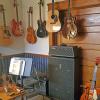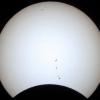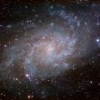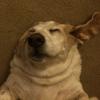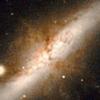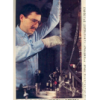
CPC Mount Drift
#1

Posted 14 June 2010 - 01:26 PM
If it is the drive motor tracking too fast, how can I solve it? If it's not, then what could it be?
Roy
#2

Posted 14 June 2010 - 01:42 PM
If it's not, then what could it be?
Roy
Hi, Roy.
Some possibilities exist. A really bad PEC training can cause an effective tracking rate error (too many East corrections). Slop between the guide scope and the imaging scope can cause apparent drift. Turning off both PEC and the guide camera would eliminate those as possibilities.
#3

Posted 14 June 2010 - 01:54 PM
Good Luck
#4

Posted 14 June 2010 - 02:19 PM
Some possibilities exist. A really bad PEC training can cause an effective tracking rate error (too many East corrections). Slop between the guide scope and the imaging scope can cause apparent drift. Turning off both PEC and the guide camera would eliminate those as possibilities.
I looked into the PEC last night. I did a 5 minute guided run with both PEC on and off and it was pretty much the same end result (though the autoguider was working a bit harder with the PEC off).
Slop on the guide scope should not be an issue. Its pretty solid.
Roy
#5

Posted 14 June 2010 - 02:26 PM
I had a similar problem last year and it turned out to be a balance issue.
I'll double check today and make sure things are balanced correctly as well. But could be that becuase of the new filter wheel the balance through the night gets out of wack.
Roy
#6

Posted 14 June 2010 - 02:32 PM
You didn't say whether you drift-aligned after you polar aligned the mount.
I know that if I only polar align using the CPC built in function on the mount, my polar alignment is not nearly accurate enough.
Hope this helps,
CTSS
#7

Posted 14 June 2010 - 03:32 PM
I also checked my balance and while it was off just a bit, it was not on the axis I am having issue with.
Roy
#8

Posted 14 June 2010 - 03:36 PM
Your best solution is Off Axis Guider. I replaced my ST80 guide scope with OAG and the problem went away. I never drift align. I polar align using CPC hand controller and it works pretty well. I always do two star align, then polar align, then double check two star align, double check polar align and once more triple check two star align. I know the latest firmware says it's not necessary to double check but I do anyway. Also, I always forget to do this, after polar align, ALWAYS do an UNSYNC otherwise your GOTO may be quite a bit off. One night I did the triple checking, I didn't UNSYNC after each polar align and my GOTO was a mile off.
See my latest M57 image taken last Saturday using Hutech OAG and Lodestar autoguider:
http://www.cloudynig...5/o/all/fpart/1
The nice thing about using OAG is I don't need to add counterweight. I have an ADM Losmandy dovetail with a ADM CW adapter but no CW is mounted. The CW adapter acts like a CW. It's not even 100% balanced but very close so don't try too hard to get it perfectly balanced.
Also, make sure both RA and Dec locks are pretty tight. This is equally important as balancing. Over tightening won't hurt anything.
Peter
#9

Posted 14 June 2010 - 04:07 PM
If you are guiding an SCT with moving mirrors using a guide scope, it's a classic mirror flop. It does not matter how tight your guiding system is, you will always get image shifts in between subs. The guide scope has no idea the SCT mirror is moving during guiding and the guide scope will never be in sync with a moving SCT mirror. I know this and I have been there.
Ok.. This sounds like a perfectly valid reason. I had not thought about the mirror in the SCT moving, but it does explain a number of other things as well (focus changing more than one would expect is one that comes to mind).
Your best solution is Off Axis Guider. I replaced my ST80 guide scope with OAG and the problem went away.
I tried an OAG at one point .. But to be fair, it was a cheap Meade OAG along with my SSAG .. it just never worked well. I guess I can try the one your using and see how it does. Also (and I know this is not on topic), how well does the Loadstar guider work .. it is pretty sensative (compared to the SSAG).
See my latest M57 image taken last Saturday using Hutech OAG and Lodestar autoguider:
Very nice. This is why I would have expected the mount itself to not have so much of an issue. I'm still a long way off from 10 min subs, but as soon as I get the tracking working then I hope to get something close.
Roy
#10

Posted 14 June 2010 - 04:45 PM
OAG is always difficult to use for beginners. There is no good training manual for this. My trick is to get both image and guide cameras parfocal (focused) during the day. Then I mark the parfocal position of Lodestar with a parfocalizing ring ( http://www.scopestuff.com/ss_par1.htm ). I tried using OAG for the first time at night and it was a nightmare. Now, after using several times, it's as easy (or easier) than using guide scope.
My OAG is not cheap but worth every penny: http://www.sciencece.../mitsub/oag.htm . There are other high quality OAGs out there at about the same price as mine. Google for "Off Axis Guider".
Good luck,
Peter
#11

Posted 14 June 2010 - 05:16 PM
I may also try another test as well and take the SCT mirror out of play all together. I can hook up my SSAG to my finder scope (I have an adapter for that) and the camera to my AT66 guide scope. Then I know I have no mirror shift involved.
Roy
#12

Posted 14 June 2010 - 06:00 PM
When you test with OAG, make sure the setup is well balanced and RA/Dec lock knobs are TIGHT.
Peter
#13

Posted 23 June 2010 - 02:04 PM
Can you tell me about any hard to use issues you have had and was to make things easier. I hope to have it this weekend to play with before the next full moon.
#14

Posted 23 June 2010 - 02:32 PM
I practice parfocalizing both image and guide cameras during the day. I focus at a street light about half an mile away. Once I got both cameras focused, I marked the focus point on the autoguider by using parfocal ring ( http://www.scopestuff.com/ss_par1.htm ) so that the guide camera will always be at the same spot everytime. It should be at the same spot with or without focal reducer. Daytime is the best and easiest way to make the setup much easier at night. Do not over-expose, start at 0.001 sec (1 msec) and go from there. Be patient and once you get the hang of it, it'll be as easy as using the guide scope. So far I have not had to hunt for a guide star in my very heavily light polluted area. I give most credits to Lodestar because it's so much more sensitive than SSAG.
Here is my latest image from last Friday night:
NGC 4565: http://img819.images...levelsgradx.jpg
7 x 15 minutes at F/10 (no focal reducer) using SXVR-M25C CCD color camera, Hutech OAG and Lodestar. This was taken during first quarter moon and the moon was near the galaxy.
Peter
#15

Posted 23 June 2010 - 06:22 PM
I also tested my mount using just my current guidescope (AT66ED) and was able to do 10 min exposures with NO GUIDING and had very little (if even noticable) errors on the individual subs (the offset was visible on the stacked images). So I am hoping that an OAG on the main scope will be just as good if not better.
Thanks for the help!
Roy



